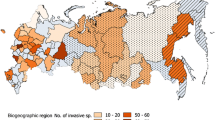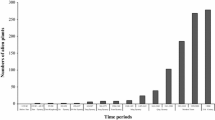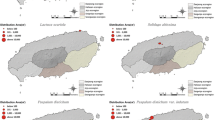Abstract
With ongoing development of global economy and increasing trade between countries, China faces increasingly serious invasions by alien species, causing great harm and potential disasters to agriculture, forestry and natural environment. According to a national survey of invasive alien species in China, there are 265 species of invasive alien plants and 171 species of invasive alien animals in China, most of which are widely distributed. In general, there are more invasive species, either plants or animals, in the south than in the north, and more in coastal areas than in interior areas. The distribution of first detection locations of invasive alien plants and animals shows a similar pattern. The cluster analyses showed that the distribution of invasive alien plants and animals was significantly influenced by geographical region, and the alien species of invasive plants and animals were similar in the same geographical region. Thus, the overall distribution of invasive alien plants and animals are spatially similar in China. The results remind us an ongoing invasion pressure from other countries to China and from the provinces with more invasive species to the provinces with less invasive species. Considering different biological and ecological characteristics of plants and animals, common social-economic factors and environmental conditions in each province lead to such similar spatial patterns, supporting the distribution prediction of establishment possibility based on the invasive pest assemblages.






Similar content being viewed by others
References
Alpert P, Bone E, Holzapfel C (2000) Invasiveness, invisibility and the role of environmental stress in the spread of non-native plants. Perspect Plant Ecol 3(1):52–66
Bradley BA, Early R, Sorte CJB (2015) Space to invade? Comparative range infilling and potential range of invasive and native plants. Global Ecol Biogeogr 24:348–359
Essl F, Dullinger S, Rabitsch W et al (2011) Socioeconomic legacy yields an invasion debt. PNAS 108(1):203–207
Huang QQ (2011) Distribution of invasive plants in China in relation to geographical origin and life cycle. Weed Res 51(5):534–542
Huang DC (2012) Spatial pattern and determinants of the first detection locations of invasive alien species in mainland China. PLoS ONE 7(2):e31734
Hulme PE (2009) Trade, transport and trouble: managing invasive species pathways in an ear of globalization. J Appl Ecol 46:10–18
Hulme PE (2011) Addressing the threat to biodiversity from botanic gardens. TREE 26(4):168–174
Hulme PE (2014) Resolving whether botanic gardens are on the road to conservation or a pathway for plant invasions. Conserv Biol. doi:10.1111/cobi.12426
Liebhold AM (2012) Live plant imports: the major pathways for forest insect and pathogen invasions of the US. Front Ecol Environ 10(3):135–143
Liu J, Liang SC, Liu FH, Wang RQ, Dong M (2005) Invasive alien plant species in China: regional distribution patterns. Divers Distrib 11(4):341–347
Magarey RD, Colunga-Garcia M, Fieselmann DA (2009) Plant biosecurity in the United States: roles, responsibilities, and information needs. Bioscience 59(10):875–884
Meyerson LA, Mooney HA (2007) Invasive alien species in an era of globalization. Front Ecol Environ 5(4):199–208
Murray BR, Philips ML (2012) Temporal introduction patterns of invasive alien plant species to Australia. NeoBiota 13:1–14
Paini DR, Worner SP, Cook DC, De Barro PJ, Thomas MB (2010) Threat of invasive pests from within national borders. Nat Commun 1:118
Paini DR, Bianchi FJJA, Northfield TD, De Barro PJ (2011) Predicting invasive fungal pathogens using invasive pest assemblages: testing model predictions in a virtual world. PLoS ONE 6(10):e25695
Pimentel D, Lach L, Zuniga R, Morrison D (2000) Environmental and economic costs of nonindigenous species in the United States. Bioscience 50(1):53–65
Pimentel D, McNair S, Janecka J, Wightman J, Simmonds C, O’Connell C, Wong E, Russel L, Zern J, Aquino T, Tsomondo T (2001) Economic and environmental threats of alien plant, animal, and microbe invasions. Agric Ecosyst Environ 84(1):1–20
Qiu J (2013) China battles army of invaders. Nature 503:450–451
Rabitsch W, Essl F (2006) Biological invasions in Austria: patterns and case studies. Biol Invasions 8:295–308
Richardson DM, Carruthers J, Hui C, Impson FAC, Miller JT, Robertson MP, Rouget M, Roux JJL, Wilson JRU (2011) Human-mediated introductions of Australian acacias: a global experiment in biogeography. Divers Distrib 17:771–787
Ricotta C, Celesti-Grapow L, Kühn I, Rapson G, Pyšek P, La Sorte FA, Thompson K (2014) Geographical constraints are stronger than invasion patterns for European urban floras. PLoS ONE 9(1):e85661
Stohlgren TJ, Barnett D, Kartez JT (2003) The rich get richer: patterns of plant invasions in the United States. Front Ecol Environ 1(1):11–14
Wang C, Zhang XL, Pan XB, Li ZH, Zhu SF (2015) Greenhouses: hotspots in the invasive network for alien species. Biodivers Conserv. doi:10.1007/s10531-015-0876-x
Weber E, Li B (2008) Plant Invasions in China: what is to be expected in the wake of economic development? Bioscience 58(5):437–444
Weber E, Sun SG, Li B (2008) Invasive alien plants in China: diversity and ecological insights. Biol Invasions 10:1411–1429
Wu XW, Luo J, Chen JK, Li B (2006) Spatial patterns of invasive alien plants in China and its relationship with environmental and anthropological factors. J Plant Ecol 30(4):576–584
Wu SH, Sun HT, Teng YC, Rejmanek M (2010) Patterns of plant invasions in China: taxonomic, biogeographic, climatic approaches and anthropogenic effects. Biol Invasions 12:2179–2206
Xu HG, Qiang S (2011) Chinese invasive alien species. Science Publisher, Beijing
Xu HG, Wang JM, Qiang S, Wang CY (2004) Alien species invasion biosafety genetic resources. Technology Publisher, Beijing
Xu H, Chen K, Pan X, Zhu S (2012a) Threats of invasive species for China caused by expanding international trade. Environ Sci Technol 46(13):7063–7064
Xu HG, Qiang S, Genovesi P, Ding Hui WuJ, Meng L, Han Z, Miao J, Hu B, Guo J, Sun H, Huang C, Lei J, Le Z, Zhang X, He S, Wu Y, Zheng Z, Chen L, Jarosik V, Pysek P (2012b) An inventory of invasive alien species in China. NeoBiota 15:1–26
Xu H, Pan X, Song Y, Huang Y, Sun M, Zhu S (2014) Intentionally introduced species: more easily invited than removed. Biodivers Conserv 23(10):2637–2643
Zhang S, Guo S, Guan M (2010) Diversity differentiation of invasive plants at a regional scale in China and its influencing factors: according to analyses on the data from 74 regions. Acta Ecol Sin 30(16):4241–4256
Acknowledgments
The authors are grateful to Mark van Kleunen, Chi Yuan and Fengqiao Liu for their kind manuscript suggestions and revision. The work is supported by the Basic Scientific Research Foundation of Chinese Academy of Inspection and Quarantine (number 2014JK014 and 2014JK015), Public Welfare Project for Quality Supervision, Inspection and Quarantine (number 201310091 and 201410080) and the S&T Project (number 2014IK019 and 2014IK290) of General Administration of Quality Supervision, Inspection and Quarantine of the People’s Republic of China. Pan X. also thanks for personal financial support from Scientific Research Foundations for the Returned Overseas Chinese Scholars, Ministry of Labour and Social Security and Ministry of Education, the People’s Republic of China and Beijing Nova Programme. We also thank the people that worked very hard on making the national inventory of invasive species in China.
Conflict of interest
The authors declare that they have no conflict of interest.
Author information
Authors and Affiliations
Corresponding authors
Rights and permissions
About this article
Cite this article
Pan, X., Zhang, J., Xu, H. et al. Spatial similarity in the distribution of invasive alien plants and animals in China. Nat Hazards 77, 1751–1764 (2015). https://doi.org/10.1007/s11069-015-1672-3
Received:
Accepted:
Published:
Issue Date:
DOI: https://doi.org/10.1007/s11069-015-1672-3




